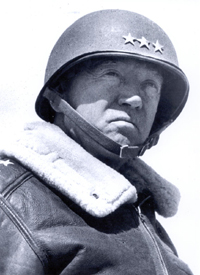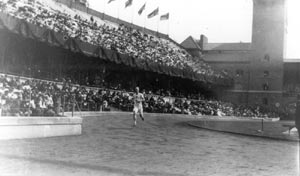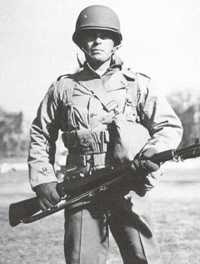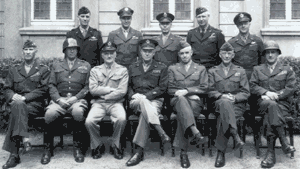|

One of the most complicated military men of all time, General George Smith Patton, Jr. was born November 11, 1885 in San Gabriel, California. He was known for carrying pistols with ivory handles and his intemperate manner, and is regarded as one of the most successful United States field commanders of any war. He continually strove to train his troops to the highest standard of excellence.
Patton decided during childhood that his goal in life was to become a hero. His ancestors had fought in the Revolutionary War, the Mexican War and the Civil War, and he grew up listening to stories of their brave and successful endeavors. He attended the Virginia Military Institute for one year and went on to graduate from the United States Military Academy at West Point on June 11, 1909. He was then commissioned a Second Lieutenant in the 15th cavalry Regiment.
Patton married Beatrice Ayer, whom he dated while at West Point, on May 26, 1910. In 1912 he represented the United States at the Stockholm Olympics in the first Modern Pentathlon. Originally open only to military officers, it was considered a rigorous test of the skills a soldier should possess. Twenty-six year old Patton did remarkably well in the multi-event sport, consisting of pistol shooting from 25 meters, sword fencing, a 300 meter free style swim, 800 meters horse back riding and a 4-kilometer cross country run. He placed fifth overall, despite a disappointing development in the shooting portion. While most chose .22 revolvers, Patton felt the  event's military roots garnered a more appropriate weapon, the .38. During the competition Patton was docked for missing the target, though he contended the lost bullet had simply passed through a large opening created by previous rounds from the .38, which left considerably larger holes. event's military roots garnered a more appropriate weapon, the .38. During the competition Patton was docked for missing the target, though he contended the lost bullet had simply passed through a large opening created by previous rounds from the .38, which left considerably larger holes.
After the Olympics, Patton kept busy taking lessons at the French cavalry School and studying French sword drills. In the summer of 1913, Patton received orders to report to the commandant of the Mounted Service School in Fort Riley, Kansas, where he became the school's first Master of the Sword. He designed and taught a course in swordsmanship while he was a student at the school.
Patton's first real exposure to battle occurred when he served as a member of legendary General John J. Pershing's staff during the expedition to Mexico. In 1915, Patton was sent to Fort Bliss along the Mexican border where he led routine cavalry patrols. A year later, he accompanied Pershing as an aide on his expedition against Francisco "Pancho" Villa into Mexico. Patton gained recognition from the press for his attacks on several of Villa's men. border where he led routine cavalry patrols. A year later, he accompanied Pershing as an aide on his expedition against Francisco "Pancho" Villa into Mexico. Patton gained recognition from the press for his attacks on several of Villa's men.
Impressed by Patton's determination, Pershing promoted him to Captain and asked him to command his Headquarters Troop upon their return from Mexico. With the onset of World War I in 1914, tanks were not being widely used. In 1917, however, Patton became the first member of the newly established United States Tank Corps, where he served until the Corps were abolished in 1920. He took full command of the Corps, directing ideas, procedures and even the design of their uniforms. Along with the British tankers, he and his men achieved victory at Cambrai, France, during the world's first major tank battle in 1917.
Using his first-hand knowledge of tanks, Patton organized the American tank school in Bourg, France and trained the first 500 American tankers. He had 345 tanks by the time he took the brigade into the Meuse-Argonne Operation in September 1918. When they entered into battle, Patton had worked out a plan where he could be in the front lines maintaining communications with his rear command post by means of pigeons and a group of runners. Patton continually exposed himself to gunfire and was shot once in the leg while he was directing the tanks. His actions during that battle earned him the Distinguished Service Cross for Heroism, one of the many medals he would collect during his lifetime.
An outspoken advocate for tanks, Patton saw them as the future of modern combat.  Congress, however, was not willing to appropriate funds to build a large armored force. Even so, Patton studied, wrote extensively and carried out experiments to improve radio communications between tanks. He also helped invent the co-axial tank mount for cannons and machine guns. Congress, however, was not willing to appropriate funds to build a large armored force. Even so, Patton studied, wrote extensively and carried out experiments to improve radio communications between tanks. He also helped invent the co-axial tank mount for cannons and machine guns.
After WWI, Patton held a variety of staff jobs in Hawaii and Washington, D.C. He graduated from the Command and General Staff School in 1924, and completed his military schooling as a distinguished graduate of the Army War College in 1932.
When the German Blitzkrieg began on Europe, Patton finally convinced Congress that the United States needed a more powerful armored striking force. With the formation of the Armored Force in 1940, he was transferred to the Second Armored Division at Fort Benning, Georgia and named Commanding General on April 11, 1941. Two months later, Patton appeared on the cover of Life magazine. Also during this time, Patton began giving his famous "Blood and Guts" speeches in an amphitheater he had built to accommodate the entire division.
The United States officially entered World War II in December 1941, after the attack on Pearl Harbor. By November 8, 1942, Patton was commanding the Western Task Force, the only all-American force landing for Operation Torch, the Allied invasion of North Africa. After succeeding there, Patton commanded the Seventh Army during the invasion of Sicily in July 1943, and in conjunction with the British Eighth Army restored Sicily to its citizens.
Patton commanded the Seventh Army until 1944, when he was given command of the Third Army in France. Patton and his troops dashed across Europe after the battle of Normandy and exploited German weaknesses with great success, covering the 600 miles across France, Belgium, Luxembourg, Germany, Austria and Czechoslovakia. When the Third Army liberated the Buchenwald concentration camp, Patton slowed his pace. He instituted a policy, later adopted by other commanders, of making local German civilians tour the camps. By the time WWII was over, the Third Army had liberated or conquered 81,522 square miles of territory. the Third Army in France. Patton and his troops dashed across Europe after the battle of Normandy and exploited German weaknesses with great success, covering the 600 miles across France, Belgium, Luxembourg, Germany, Austria and Czechoslovakia. When the Third Army liberated the Buchenwald concentration camp, Patton slowed his pace. He instituted a policy, later adopted by other commanders, of making local German civilians tour the camps. By the time WWII was over, the Third Army had liberated or conquered 81,522 square miles of territory.
In October 1945, Patton assumed command of the Fifteenth Army in American-occupied Germany. On December 9, he suffered injuries as the result of an automobile accident. He died 12 days later, on December 21, 1945 and is buried among the soldiers who died in the Battle of the Bulge in Hamm, Luxembourg.
Remembered for his fierce determination and ability to lead soldiers, Patton is now considered one of the greatest military figures in history. The 1970 film, "Patton," starring George C. Scott in the title role, provoked renewed interest in Patton. The movie won seven Academy Awards, including Best Actor and Best Picture, and immortalized General George Smith Patton, Jr. as one of the world's most intriguing military men. |






![]()


